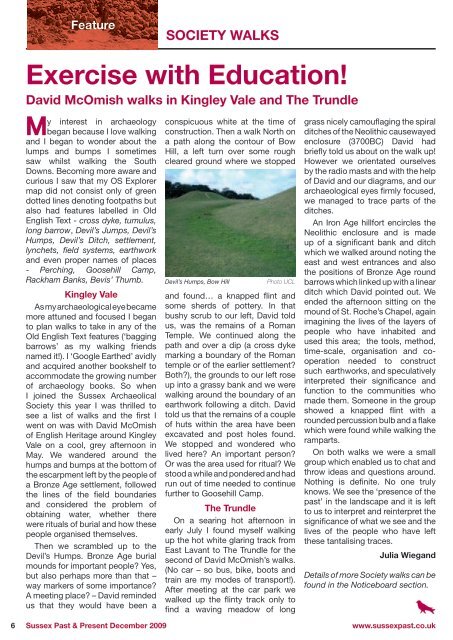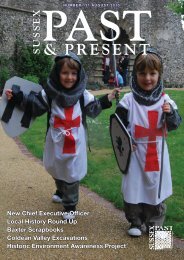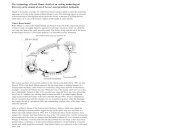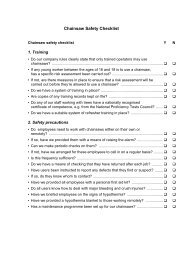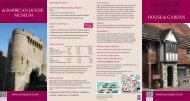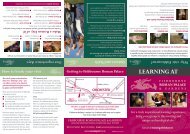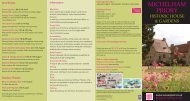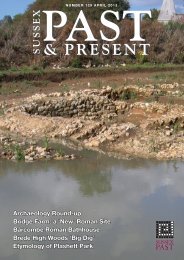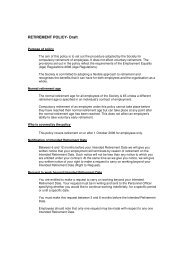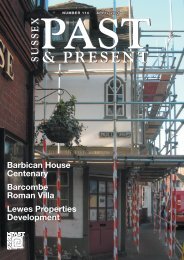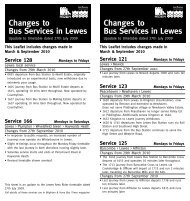December 2009 (issue 119) - The Sussex Archaeological Society
December 2009 (issue 119) - The Sussex Archaeological Society
December 2009 (issue 119) - The Sussex Archaeological Society
- No tags were found...
You also want an ePaper? Increase the reach of your titles
YUMPU automatically turns print PDFs into web optimized ePapers that Google loves.
Feature<br />
SOCIETY WALKS<br />
EDUCATION AWARDS<br />
Feature<br />
Exercise with Education!<br />
David McOmish walks in Kingley Vale and <strong>The</strong> Trundle<br />
My interest in archaeology<br />
began because I love walking<br />
and I began to wonder about the<br />
lumps and bumps I sometimes<br />
saw whilst walking the South<br />
Downs. Becoming more aware and<br />
curious I saw that my OS Explorer<br />
map did not consist only of green<br />
dotted lines denoting footpaths but<br />
also had features labelled in Old<br />
English Text - cross dyke, tumulus,<br />
long barrow, Devil’s Jumps, Devil’s<br />
Humps, Devil’s Ditch, settlement,<br />
lynchets, field systems, earthwork<br />
and even proper names of places<br />
- Perching, Goosehill Camp,<br />
Rackham Banks, Bevis’ Thumb.<br />
Kingley Vale<br />
As my archaeological eye became<br />
more attuned and focused I began<br />
to plan walks to take in any of the<br />
Old English Text features (‘bagging<br />
barrows’ as my walking friends<br />
named it!). I ‘Google Earthed’ avidly<br />
and acquired another bookshelf to<br />
accommodate the growing number<br />
of archaeology books. So when<br />
I joined the <strong>Sussex</strong> Archaeolical<br />
<strong>Society</strong> this year I was thrilled to<br />
see a list of walks and the first I<br />
went on was with David McOmish<br />
of English Heritage around Kingley<br />
Vale on a cool, grey afternoon in<br />
May. We wandered around the<br />
humps and bumps at the bottom of<br />
the escarpment left by the people of<br />
a Bronze Age settlement, followed<br />
the lines of the field boundaries<br />
and considered the problem of<br />
obtaining water, whether there<br />
were rituals of burial and how these<br />
people organised themselves.<br />
<strong>The</strong>n we scrambled up to the<br />
Devil’s Humps. Bronze Age burial<br />
mounds for important people Yes,<br />
but also perhaps more than that –<br />
way markers of some importance<br />
A meeting place – David reminded<br />
us that they would have been a<br />
conspicuous white at the time of<br />
construction. <strong>The</strong>n a walk North on<br />
a path along the contour of Bow<br />
Hill, a left turn over some rough<br />
cleared ground where we stopped<br />
Devil’s Humps, Bow Hill<br />
Photo UCL<br />
and found… a knapped flint and<br />
some sherds of pottery. In that<br />
bushy scrub to our left, David told<br />
us, was the remains of a Roman<br />
Temple. We continued along the<br />
path and over a dip (a cross dyke<br />
marking a boundary of the Roman<br />
temple or of the earlier settlement<br />
Both), the grounds to our left rose<br />
up into a grassy bank and we were<br />
walking around the boundary of an<br />
earthwork following a ditch. David<br />
told us that the remains of a couple<br />
of huts within the area have been<br />
excavated and post holes found.<br />
We stopped and wondered who<br />
lived here An important person<br />
Or was the area used for ritual We<br />
stood a while and pondered and had<br />
run out of time needed to continue<br />
further to Goosehill Camp.<br />
<strong>The</strong> Trundle<br />
On a searing hot afternoon in<br />
early July I found myself walking<br />
up the hot white glaring track from<br />
East Lavant to <strong>The</strong> Trundle for the<br />
second of David McOmish’s walks.<br />
(No car – so bus, bike, boots and<br />
train are my modes of transport!).<br />
After meeting at the car park we<br />
walked up the flinty track only to<br />
find a waving meadow of long<br />
grass nicely camouflaging the spiral<br />
ditches of the Neolithic causewayed<br />
enclosure (3700BC) David had<br />
briefly told us about on the walk up!<br />
However we orientated ourselves<br />
by the radio masts and with the help<br />
of David and our diagrams, and our<br />
archaeological eyes firmly focused,<br />
we managed to trace parts of the<br />
ditches.<br />
An Iron Age hillfort encircles the<br />
Neolithic enclosure and is made<br />
up of a significant bank and ditch<br />
which we walked around noting the<br />
east and west entrances and also<br />
the positions of Bronze Age round<br />
barrows which linked up with a linear<br />
ditch which David pointed out. We<br />
ended the afternoon sitting on the<br />
mound of St. Roche’s Chapel, again<br />
imagining the lives of the layers of<br />
people who have inhabited and<br />
used this area; the tools, method,<br />
time-scale, organisation and cooperation<br />
needed to construct<br />
such earthworks, and speculatively<br />
interpreted their significance and<br />
function to the communities who<br />
made them. Someone in the group<br />
showed a knapped flint with a<br />
rounded percussion bulb and a flake<br />
which were found while walking the<br />
ramparts.<br />
On both walks we were a small<br />
group which enabled us to chat and<br />
throw ideas and questions around.<br />
Nothing is definite. No one truly<br />
knows. We see the ‘presence of the<br />
past’ in the landscape and it is left<br />
to us to interpret and reinterpret the<br />
significance of what we see and the<br />
lives of the people who have left<br />
these tantalising traces.<br />
Julia Wiegand<br />
Details of more <strong>Society</strong> walks can be<br />
found in the Noticeboard section.<br />
Palace Team Wins Top Award<br />
Education Team’s excellence recognised<br />
Congratulations are due<br />
to the education team at<br />
Fishbourne Roman Palace on two<br />
separate counts! In recognition of<br />
the excellence of their education<br />
programme the team as a whole<br />
have received a Sandford Award<br />
for Heritage Education, and Jean<br />
Jennings, a member of the team, is<br />
one of six finalists who have been<br />
shortlisted for this year’s Marsh<br />
Archaeology Award.<br />
<strong>The</strong> prestigious Sandford awards,<br />
which are valid for five years, are<br />
given by the Heritage Education<br />
Trust only to organisations which<br />
have reached an exceptionally<br />
high standard in the way they<br />
teach a wide spectrum of visitors,<br />
from primary school youngsters to<br />
adults. Entrants are assessed by<br />
a panel of fourteen independent<br />
judges made up of head teachers<br />
and OFSTED inspectors who<br />
described the Palace’s education<br />
team as “friendly, well-informed<br />
and enthusiastic” in their report.<br />
<strong>The</strong>y went on to say that “those<br />
fortunate enough to undertake the<br />
Fishbourne experience will forever<br />
appreciate the building skills and<br />
technical abilities of the Romans in<br />
Britain.” Museum director Christine<br />
Medlock is delighted that the<br />
professionalism and friendly and<br />
efficient attitude of the education<br />
team has been recognised yet<br />
again with this award.<br />
As part of the ‘Fishbourne<br />
Experience’ visitors are encouraged<br />
to chat to volunteers dressed in<br />
authentic costumes, finding out<br />
what life was like in Roman times<br />
and meeting the sort of people<br />
who would have called the Palace<br />
‘home’. <strong>The</strong>re is also the chance<br />
to handle real artefacts and for<br />
schoolchildren to get their hands<br />
on a replica Roman kitchen and<br />
sample Roman-style food and drink<br />
(see above!).<br />
Hands-on experience of a Roman kitchen<br />
<strong>The</strong> annual Marsh Archaeology<br />
Award recognises individual<br />
high quality education work with<br />
people under the age of 18 in the<br />
UK and is judged according to<br />
the contribution made to passing<br />
on archaelogical knowledge to<br />
young people in the last two years.<br />
Criteria also include the level of<br />
commitment shown to education<br />
work in archaeology over and<br />
above any formal paid work, and<br />
the level of engagement in a variety<br />
of different educational contexts.<br />
Jean has worked at Fishbourne<br />
for nearly 15 years, first in the gift<br />
shop before joining the education<br />
team. She has presented hour-long<br />
workshops to many thousands of<br />
school children who visit the Palace<br />
each year. Over the last two years<br />
she has developed new workshops<br />
that support the national curriculum<br />
in a variety of areas which have<br />
been very well received by both<br />
teachers and students. Jean is<br />
also responsible for preparing an<br />
enriching programme for the many<br />
work experience students who are<br />
considering studying archaeology,<br />
history or classics at college or<br />
Photo S Evans<br />
university. She also makes a key<br />
contribution towards facilitating<br />
learning for special needs students<br />
and works many hours beyond<br />
her normal working time, planning<br />
and preparing new learning<br />
opportunities, assisting other staff<br />
and supporting the volunteers.<br />
Dr Mike Heyworth MBE, Director<br />
of the CBA, says of the short-listed<br />
candidates: “For archaeology to<br />
be cared for and understood by<br />
future generations, it is essential<br />
we pass on our knowledge and<br />
enthusiasm. <strong>The</strong>se individuals do<br />
just that, conveying a passion for<br />
our cultural heritage which will stay<br />
with young people throughout their<br />
lives. Without their work educating<br />
and guiding the next generation to<br />
an understanding of the historic<br />
environment, archaeology would<br />
face an uncertain future”.<br />
Brian Marsh OBE, chairman of<br />
the Marsh Christian Trust which<br />
sponsors the award, has the difficult<br />
job of deciding on the winner later<br />
this year.<br />
6 <strong>Sussex</strong> Past & Present <strong>December</strong> <strong>2009</strong><br />
www.sussexpast.co.uk www.romansinsussex.co.uk <strong>Sussex</strong> Past & Present <strong>December</strong> <strong>2009</strong> 7


